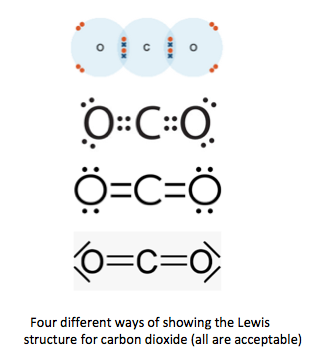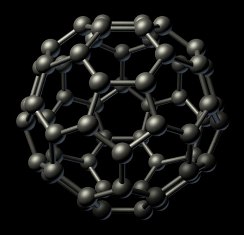4.3 Covalent structures (1)
This is the first part of sub-topic 4.3 Covalent structures. It includes Lewis structures, the 'octet rule, resonance hybrids and giant covalent structures. I have not included VSEPR theory to determine the shapes of simple molecules and ions on this page. Since the underlying theory is the same for 2, 3, 4 and 5 and 6 electrons pairs around the central atom I have prepared a separate page on VSEPR theory as 5 and 6 electron pairs are only covered at Higher Level in sub-topic 14.1.


 Learning outcomes
Learning outcomes
 After studying this topic you should be able to:
After studying this topic you should be able to:
Understand:
- The Lewis (electron dot) structure shows all the valence (outer) electrons in a covalently bonded species.
- The tendency of atoms to gain a valence shell with a total of 8 electrons is known as the 'octet rule'.
- Some atoms, e.g. Be and B, are able to form stable compounds with an incomplete octet of electrons.
- When there is more than one possible position for a double bond in a molecule resonance structures may occur.
- Giant covalent/network covalent structures are formed by silicon and allotropes of carbon.
Apply your knowledge to:
- Deduce the Lewis (electron dot) structure of molecules and ions showing all valence (outer) electrons for up to four electron pairs on each atom.
- Deduce resonance structures.
- Explain the properties of giant covalent compounds in terms of their structures.
Relationships & vocabulary
Nature of science
Models are used by scientists as representations of the real world.
International-mindedness
For examples and links to International mindedness, Theory of knowledge, utilization etc. see separate page which covers all of Topics 4 & 14: Chemical bonding & structure.
Vocabulary
| Lewis structure | resonance hybrid | valence electron | 'octet rule' |
| allotrope | graphene | Buckminsterfullerene |
Learning slides
You can use this slide gallery for learning or for reviewing concepts and information. It covers all the key points in the syllabus for this sub-topic.
Something to think about
 In 1996 the Nobel Prize for Chemistry was awarded to Robert F. Curl, Jr., Harry W. Kroto and Richard E. Smalley for their discovery of buckminsterfullerene. In the 1970s Harry Kroto from the University of Sussex was working on identifying molecules in interstellar gas clouds. Robert Curl and Richard Smalley were separately working at Rice University, Houston on using laser vaporisation techniques to produce clusters of atoms. In 1985 the two groups teamed up and by using a graphite target produced a molecule with a relative molar mass of 720 which corresponded to C60. By 1990 the structure of C60 had been confirmed by X-ray analysis. Buckminsterfullerene (named after the Buckminster Fuller Dome built for Expo '67 in Montreal, Canada) is a closed cage structure (see right) consisting of pentagons and hexagons. Each carbon atom is sp2 hybridized and bonded to three other carbon atoms. Other fullerenes , e.g. C70, have also been shown to exist. The discovery of fullerenes led to the whole new branch of science called nanotechnology which is covered in Option A: Materials (A.6 Nanotechnology). More information about the discovery of fullerenes can be found on the molecule of the month page published by Bristol University and also 'The discovery of fullerenes' produced by the American Chemical Society.
In 1996 the Nobel Prize for Chemistry was awarded to Robert F. Curl, Jr., Harry W. Kroto and Richard E. Smalley for their discovery of buckminsterfullerene. In the 1970s Harry Kroto from the University of Sussex was working on identifying molecules in interstellar gas clouds. Robert Curl and Richard Smalley were separately working at Rice University, Houston on using laser vaporisation techniques to produce clusters of atoms. In 1985 the two groups teamed up and by using a graphite target produced a molecule with a relative molar mass of 720 which corresponded to C60. By 1990 the structure of C60 had been confirmed by X-ray analysis. Buckminsterfullerene (named after the Buckminster Fuller Dome built for Expo '67 in Montreal, Canada) is a closed cage structure (see right) consisting of pentagons and hexagons. Each carbon atom is sp2 hybridized and bonded to three other carbon atoms. Other fullerenes , e.g. C70, have also been shown to exist. The discovery of fullerenes led to the whole new branch of science called nanotechnology which is covered in Option A: Materials (A.6 Nanotechnology). More information about the discovery of fullerenes can be found on the molecule of the month page published by Bristol University and also 'The discovery of fullerenes' produced by the American Chemical Society.

It is worth contrasting this discovery and the subsequent award of the Nobel Prize with the work of Gilbert Lewis (1875-1946) in the first half of the last century. Much of the theory of covalent bonding underlying the whole of this topic was first proposed by Lewis and arguably he remains the most deserving chemist never to have won a Nobel Prize even though he was nominated several times. The politics behind the chemistry and how the Nobel Prize was awarded in the first part of the 20th century is covered well in the book Cathedrals of Science written by P. Coffey.
Test your understanding of this topic
(Note that your teacher may have restricted your access to some or all of these questions and worked answers if they are going to use them as a class test or set them as an assignment.)
For ten 'quiz' multiple choice questions with the answers explained see MC test: Covalent structures (1).
For short-answer questions see Covalent structures (1) questions.
More resources
1. A video showing the different allotropes of carbon. Worth watching, not so much for the commentary, but for the excellent animation.
2. Another useful video on the allotropes of carbon produced by Dr Ainissa Ramirez of Yale University.
3. The structure and bonding in silicon and silicon dioxide are also important and are covered in this video by Richard Thornley - an IB teacher from the United Nations International School in New York.
4. A good podcast by the Royal Society of Chemistry on

 IB Docs (2) Team
IB Docs (2) Team 




























